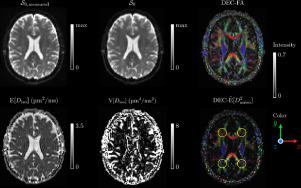Journal of Magnetic Resonance Open ( IF 1.5 ) Pub Date : 2021-07-11 , DOI: 10.1016/j.jmro.2021.100016 Alexis Reymbaut 1, 2

|
Diffusion MRI allows for the non-invasive investigation of the microscopic architecture of biological tissues in vivo. While being sensitive to microstructural tissue changes, diffusion MRI yields poor specificity regarding the cause of these changes. This specificity can be enhanced by using (i) signal representations that retrieve global diffusion properties of the voxel content from the features of the measured diffusion signal or (ii) models that relate these features to predefined sub-voxel tissue-specific compartments. Either on the voxel scale or within diffusion compartments, tissue microstructure can be described using a diffusion tensor distribution (DTD) , which captures a collection of microscopic diffusion environments. A convenient way to estimate DTDs relies on choosing a plausible parametric functional form approximating them. In particular, the mean diffusion tensor and covariance tensor associated with this choice enable derivation of measures quantifying specific microstructural diffusion properties. However, high-dimensional DTDs can be quite intractable in practice. In this tutorial paper, we present the matrix moments of , which allow computation of the mean diffusion tensor, covariance tensor and higher-order statistical tensors for any arbitrary functional choice approximating . In turn, these statistical tensors are related to common diffusion measures, such as the mean diffusivity, microscopic diffusion anisotropy and variance of isotropic diffusivities. Using the well-known case of the matrix-variate Gaussian distribution to validate the matrix moments, we then use these tools on the more complex non-central matrix-variate Gamma distribution, computing its covariance tensor for the first time. Finally, we utilize this covariance tensor to design a new voxel-scale signal representation, the matrix-variate Gamma approximation, which we evaluate in vivo and compare to q-space trajectory imaging (QTI) in silico. While the matrix-variate Gamma approximation possesses important limitations explained by the structure of its newly computed covariance tensor, it presents a greater accuracy than QTI in systems exhibiting high orientational order, which suggests that non-central matrix-variate Gamma distributions appropriately describe anisotropic diffusion compartments, as in the DIAMOND model. The framework of matrix moments promotes a more widespread use of matrix-variate distributions as plausible approximations of the DTD by alleviating their intractability, thereby facilitating their design and validation.
中文翻译:

扩散张量分布的矩阵矩和矩阵变量 Gamma 近似
扩散 MRI 允许对体内生物组织的微观结构进行非侵入性研究。虽然对微观结构组织变化敏感,但扩散 MRI 对这些变化的原因的特异性较差。这种特异性可以通过使用 (i) 从测量的扩散信号的特征中检索体素内容的全局扩散特性的信号表示或 (ii) 将这些特征与预定义的子体素组织特异性隔室相关联的模型来增强。无论是在体素尺度上还是在扩散隔室内,组织微观结构都可以使用扩散张量分布 (DTD) 来描述,它捕获了一组微观扩散环境。一种估计 DTD 的便捷方法依赖于选择一个合理的参数函数形式来逼近它们。特别是,平均扩散张量 和协方差张量 与此选择相关联,可以推导出量化特定微观结构扩散特性的措施。然而,高维 DTD 在实践中可能非常棘手。在本教程论文中,我们介绍了矩阵矩,这允许计算任何任意函数选择近似的平均扩散张量、协方差张量和高阶统计张量 . 反过来,这些统计张量与常见的扩散度量有关,例如平均扩散率、微观扩散各向异性和各向同性扩散率的方差。使用矩阵变量高斯分布的众所周知的情况来验证矩阵矩,然后我们在更复杂的非中心矩阵变量 Gamma 分布上使用这些工具,首次计算其协方差张量。最后,我们利用这个协方差张量来设计一个新的体素尺度信号表示,矩阵变量 Gamma 近似,我们在体内评估并与 q 空间轨迹成像 (QTI)进行比较. 虽然矩阵变量 Gamma 近似具有由其新计算的协方差张量的结构解释的重要局限性,但它在表现出高取向顺序的系统中表现出比 QTI 更高的精度,这表明非中心矩阵变量 Gamma 分布适当地描述了各向异性扩散隔间,如 DIAMOND 模型。矩阵矩的框架通过减轻它们的难处理性来促进矩阵变量分布作为 DTD 的似是而非的近似值的更广泛使用,从而促进它们的设计和验证。











































 京公网安备 11010802027423号
京公网安备 11010802027423号